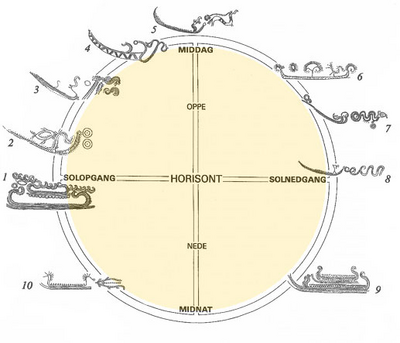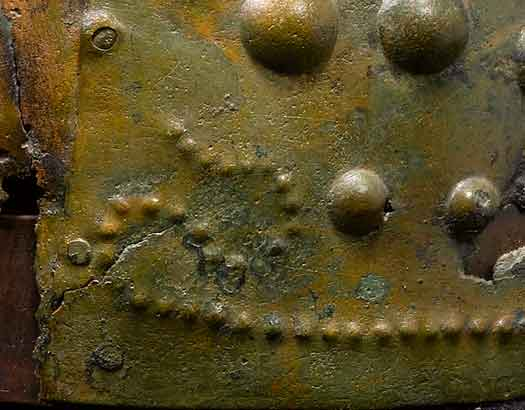Helmets with holy symbols
The horned helmets from Viksø are more than just helmets. To the people of the Bronze Age they were rich in religious meaning and probably related to myths about holy animals and divine powers. They functioned both as helmets and masks, as they were equipped with eyes and a hooked beak. The hooked beak of a bird of prey and the large, round eyes perhaps indicate that it is an owl.
Further features are connected to animals. The horns on the helmets must relate to the ox. A comb with a groove intended for the insertion of hair is located upon the crown. This hair may have been from a horse, so that the helmets had manes like horses. Finally feathers from a crane or another large bird could be stuck in to the two small cylindrical fittings and in the ends of both horns. But why was it important to incorporate all these different animals into the design of the helmets?
Along the edge at the base of the helmets are stylised ship pictures made out of a row of small hammered dents. On each helmet are two ships, which stretch from the front to the back of the helmet. The ship’s prow is furnished with a water bird – duck, swan or grebe. This is the Sun Ship, the most important religious symbol of the Bronze Age. The water bird had a special significance in Bronze Age perception of the sun’s continual cycle. The bird could follow the sun and its light in all places and environments. It could dive under water, swim, walk on the earth and fly in the sky.
The sun’s journey
The picture of the Sun Ship on the helmets from Viksø refers to a central myth in Bronze Age religion. This is the myth of the sun’s eternal journey round and round, with the help of the Sun Ship. The other important helper on this journey is the sun horse, which pulls the sun across the sky. The horse, which is the noblest and holiest of all animals, is represented on the helmets in the form of a mane. The ox, represented by the horns, can symbolise strength and wealth. In many religions the ox is also a heavenly symbol. The bird of prey, which constitutes the masks on the helmets, may also be connected to the myth about the sun’s eternal journey. If it is an owl, this probably relates to night-time. Finally the added feathers from the crane, which can also be seen in Bronze Age rock carvings from Sweden, may be connected to the changing of the seasons. The crane is the largest and most beautiful of the migratory birds.
The whole symbolic world, which is represented on the Viksø helmets, emphasises their function as holy objects used in religious rituals.

The sun's journey across the sky can be illustrated by the pictures shown on razors from the Bronze Age. Read more about Bronze Age religion here.

